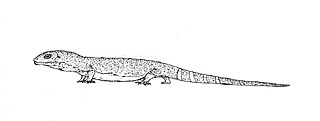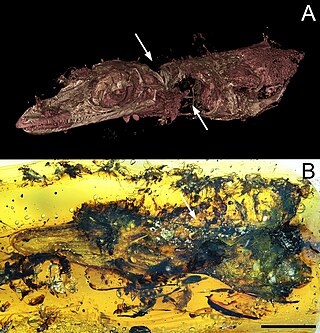
Lizard is the common name used for all squamate reptiles other than snakes, encompassing over 7,000 species, ranging across all continents except Antarctica, as well as most oceanic island chains. The grouping is paraphyletic as some lizards are more closely related to snakes than they are to other lizards. Lizards range in size from chameleons and geckos a few centimeters long to the 3-meter-long Komodo dragon.

Chameleons or chamaeleons are a distinctive and highly specialized clade of Old World lizards with 200 species described as of June 2015. The members of this family are best known for their distinct range of colours, being capable of colour-shifting camouflage. The large number of species in the family exhibit considerable variability in their capacity to change colour. For some, it is more of a shift of brightness ; for others, a plethora of colour-combinations can be seen.

Agamidae is a family of over 550 species of iguanian lizards indigenous to Africa, Asia, Australia, and a few in Southern Europe. Many species are commonly called dragons or dragon lizards.

Albanerpeton is an extinct genus of salamander-like albanerpetontid amphibian found in North America, Europe and Asia first appearing in Cretaceous-aged strata. There are eight described members of the genus, and one undiagnosed species from the Paskapoo Formation, making it by far the most speciose genus in the family. Members of the genus had a robust head and neck which likely allowed them to actively burrow, characteristic of fossorial species, and they lived in a wide range of environments. This genus of amphibian was the last of its order, surviving until into the Early Pleistocene (Gelasian) of northern Italy, and possibly northern Spain, until around 2 million years ago. It likely became extinct when the region developed its present Mediterranean-type climate, having preferred one that was cold and humid. The monophyly of Albanerpeton has recently been questioned, with some authors regarding the genus as paraphyletic.

The Albanerpetontidae are an extinct family of small amphibians, native to the Northern Hemisphere during the Mesozoic and Cenozoic. The only members of the order Allocaudata, they are thought to be allied with living amphibians belonging to Lissamphibia. Despite a superficially salamander-like bodyform, their anatomy is strongly divergent from modern amphibians in numerous aspects. The fossil record of albanerpetontids spans over 160 million years from the Middle Jurassic to the beginning of the Pleistocene, about 2.13–2 million years ago.

Anoualerpeton is an extinct genus of lissamphibian in the family Albanerpetontidae. It is the oldest and most primitive albanerpetontid known. Fossils have been found of two different species, Anoualerpeton priscus from the Middle Jurassic (Bathonian) aged Forest Marble and Kilmaluag formations of England and Scotland, and Anoualerpeton unicus from Late Jurassic-Early Cretaceous (Tithonian-Berriasian) Ksar Metlili Formation of Morocco. A. unicus is the only named albanerpetontid from Gondwana.

Celtedens is an extinct genus of albanerpetontid amphibian from the Early Cretaceous of England, Spain, Sweden and Italy, and the Late Jurassic of Portugal.
The Kuwajima Formation is an Early Cretaceous geologic formation in Japan. Its precise age is uncertain due to a lack of identifying fossils, and it was previously considered likely Valanginian to Hauterivian in age. However, it is now considered to probably be Barremian in age. Dinosaurs and other vertebrates has been recovered from the Kaseki-kabe "Fossil-bluff" locality in the uppermost part of the formation.

Wesserpeton is an extinct genus of albanerpetontid amphibian known from the Isle of Wight, southern England.

Astreptolabis is an extinct genus of earwig in the Dermaptera family Pygidicranidae known from a group of Cretaceous fossils found in Myanmar. The genus contains two described species, Astreptolabis ethirosomatia and Astreptolabis laevis and is the sole member of the subfamily Astreptolabidinae.

Burmese amber, also known as Myanmar amber, Burmite or Kachin amber, is amber from the Hukawng Valley in northern Myanmar. The amber is dated to around 100 million years ago, during the latest Albian to earliest Cenomanian ages of the mid-Cretaceous period. The amber is of significant palaeontological interest due to the diversity of flora and fauna contained as inclusions, particularly arthropods including insects and arachnids but also birds, lizards, snakes, frogs and fragmentary dinosaur remains. The amber has been known and commercially exploited since the first century AD, and has been known to science since the mid-nineteenth century. Research on the deposit has attracted controversy due to its alleged role in funding internal conflict in Myanmar and hazardous working conditions in the mines where it is collected.

Camelomecia is an extinct genus of stem-group ants not placed into any Formicidae subfamily. Fossils of the single known species, Camelomecia janovitzi, are known from the Middle Cretaceous of Asia. The genus is one of several ants described from Middle Cretaceous ambers of Myanmar.

Shirerpeton is an extinct genus of albanerpetontid amphibian from the Early Cretaceous Kuwajima Formation, which is located in Japan. The type species is Shirerpeton isajii, which was described by Masumoto & Evans in 2018. Shirerpeton represents the first record of Albanerpetontidae in East Asia and the holotype is SBEI 2459, a small block bearing most of a disarticulated but associated skull with some postcranial elements present as well.
Chinlestegophis is a diminutive Late Triassic stereospondyl that has been interpreted as a putative stem caecilian, a living group of legless burrowing amphibians. If Chinlestegophis is indeed both an advanced stereospondyl and a relative of caecilians, this means that stereospondyls survived to the present day; historically the group was thought to have gone extinct by the early Cretaceous. Chinlestegophis jenkinsi, the type and only species, is known from two partial skulls discovered in the Chinle Formation in Colorado.
Paleontology or palaeontology is the study of prehistoric life forms on Earth through the examination of plant and animal fossils. This includes the study of body fossils, tracks (ichnites), burrows, cast-off parts, fossilised feces (coprolites), palynomorphs and chemical residues. Because humans have encountered fossils for millennia, paleontology has a long history both before and after becoming formalized as a science. This article records significant discoveries and events related to paleontology that occurred or were published in the year 2018.
Burmese amber is fossil resin dating to the early Late Cretaceous Cenomanian age recovered from deposits in the Hukawng Valley of northern Myanmar. It is known for being one of the most diverse Cretaceous age amber paleobiotas, containing rich arthropod fossils, along with uncommon vertebrate fossils and even rare marine inclusions. A mostly complete list of all taxa described up until 2018 can be found in Ross 2018; its supplement Ross 2019b covers most of 2019.

Oculudentavis is an extinct genus of lizard of uncertain taxonomic placement, originally identified as an avialan dinosaur. It contains two known species, O. khaungraae and O. naga. Each species is known from one partial fossil specimen in Burmese amber, which differ in several proportions. Their skulls measure 1.4–1.7 centimetres (0.55–0.67 in) in length, indicating that Oculudentavis would have been comparable in size with the modern bee hummingbird if it were an avialan. Both specimens were retrieved from 99-million-year-old deposits of the Hukawng Basin in Kachin State, northern Myanmar. The type specimen of O. khaungraae is embroiled in controversy regarding its identity and the ethical issues surrounding the acquisition and study of Burmese amber. The original description advocating for an avialan identity was published in Nature, but has since then been retracted from the journal.
This list of fossil amphibians described in 2020 is a list of new taxa of fossil amphibians that were described during the year 2020, as well as other significant discoveries and events related to amphibian paleontology that occurred in 2020.

Retinosaurus is an extinct genus of scincomorph lizard from the Early Cretaceous of Myanmar. The genus contains a single species, Retinosaurus hkamtiensis, known from a specimen preserved in amber.
This list of fossil reptiles described in 2016 is a list of new taxa of fossil reptiles that were described during the year 2016, as well as other significant discoveries and events related to reptile paleontology that occurred in 2016.

















